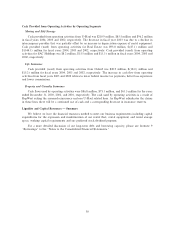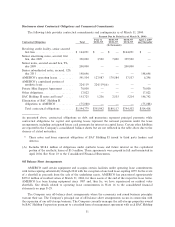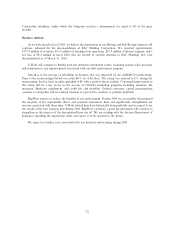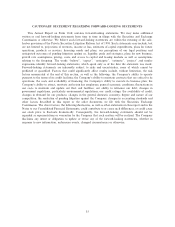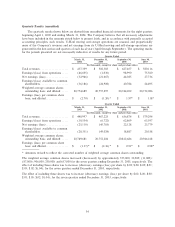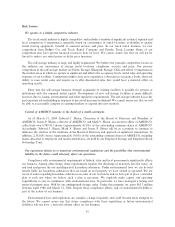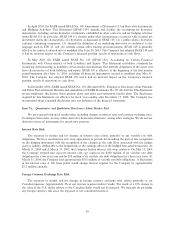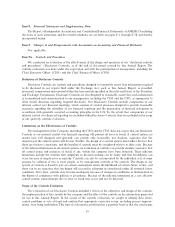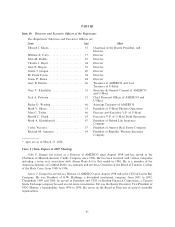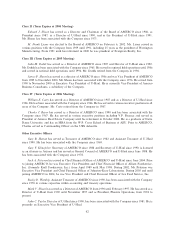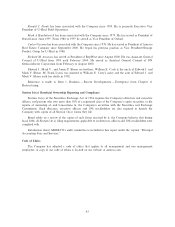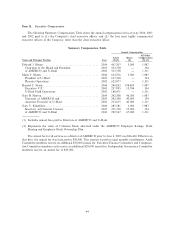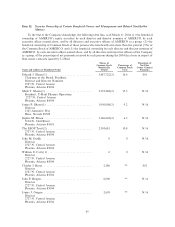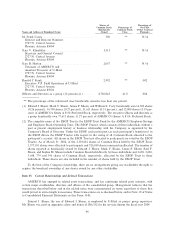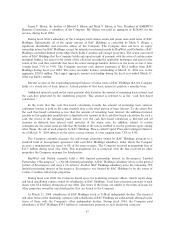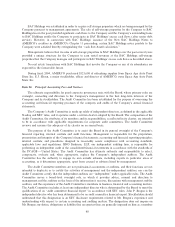U-Haul 2004 Annual Report Download - page 44
Download and view the complete annual report
Please find page 44 of the 2004 U-Haul annual report below. You can navigate through the pages in the report by either clicking on the pages listed below, or by using the keyword search tool below to find specific information within the annual report.Item 8. Financial Statements and Supplementary Data
The Report of Independent Accountants and Consolidated Financial Statements of AMERCO including
the notes to such statements and the related schedules are set forth on pages F-1 through F-58 and thereby
incorporated herein.
Item 9. Changes in and Disagreements with Accountants on Accounting and Financial Disclosure
Not applicable.
Item 9A. Controls and Procedures
We conducted an evaluation of the eÅectiveness of the design and operation of our ""disclosure controls
and procedures'' (Disclosure Controls) as of the end of the period covered by this Annual Report. The
controls evaluation was done under the supervision and with the participation of management, including the
Chief Executive OÇcer (CEO) and the Chief Financial OÇcer (CFO).
DeÑnition of Disclosure Controls
Disclosure Controls are controls and procedures designed to reasonably assure that information required
to be disclosed in our reports Ñled under the Exchange Act, such as this Annual Report, is recorded,
processed, summarized and reported within the time periods speciÑed in the rules and forms of the Securities
and Exchange Commission. Disclosure Controls are also designed to reasonably assure that such information
is accumulated and communicated to our management, including the CEO and the CFO, as appropriate to
allow timely decisions regarding required disclosure. Our Disclosure Controls include components of our
internal control over Ñnancial reporting, which consists of control processes designed to provide reasonable
assurance regarding the reliability of our Ñnancial reporting and the preparation of Ñnancial statements in
accordance with generally accepted accounting principles in the U.S. To the extent that components of our
internal control over Ñnancial reporting are included within Disclosure Controls, they are included in the scope
of our quarterly controls evaluation.
Limitations on the EÅectiveness of Controls
The management of the Company, including the CEO and the CFO, does not expect that our Disclosure
Controls or our internal control over Ñnancial reporting will prevent all error or fraud. A control system, no
matter how well designed and operated, can provide only reasonable, not absolute, assurance that the
objectives of the control system will be met. Further, the design of a control system must reÖect the fact that
there are resource constraints, and the beneÑts of controls must be considered relative to their costs. Because
of the inherent limitations in all control systems, no evaluation of controls can provide absolute assurance that
all control issues and instances of fraud, if any, within the company have been detected. These inherent
limitations include the realities that judgments in decision making can be faulty and that breakdowns can
occur because of simple error or mistake. Controls can also be circumvented by the individual acts of some
persons, by collusion of two or more people, or by management override of the controls. The design of any
system of controls is based in part on certain assumptions about the likelihood of certain future events, and
there can be no assurance that any design will succeed in achieving its stated goals under all potential future
conditions. Over time, controls may become inadequate because of changes in conditions or deterioration in
the degree of compliance with policies or procedures. Because of the inherent limitations in a cost eÅective
control system, misstatements due to error or fraud may occur and not be detected.
Scope of the Controls Evaluation
The evaluation of our Disclosure Controls included a review of the objectives and design of the controls,
the implementation of the controls by the company and the eÅect of the controls on the information generated
for use in this Annual Report. In the course of the controls evaluation, we sought to identify data errors,
control problems or acts of fraud and conÑrm that appropriate corrective action, including process improve-
ments, were being undertaken. This type of evaluation is performed on a quarterly basis so that the conclusions
39



